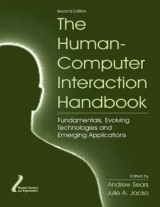
The Human-Computer Interaction Handbook
Lawrence Erlbaum Associates Inc (Verlag)
978-0-8058-3838-1 (ISBN)
- Titel erscheint in neuer Auflage
- Artikel merken
The Human-Computer Interaction Handbook: Fundamentals, Evolving Technologies, and Emerging Applications is a comprehensive survey of this fast-paced field that is of interest to all HCI practitioners, educators, consultants, and researchers. This includes computer scientists; industrial, electrical, and computer engineers; cognitive scientists; experimental psychologists; human factors professionals; interface and systems designers; product managers; and executives working with product development.
This new Handbook offers a comprehensive compendium of foundational principles, as well as the most recent advances in conceptualizing, designing, and evaluating computing technologies. It spans a variety of traditional and non-traditional platforms, including desktop and mobile computing, networked and virtual environments, and information appliances. In addition, the volume offers thorough coverage of interaction issues concerning diverse users, including men; women; children; the elderly; and those with cognitive, physical, and perceptual impairments. Another unique feature of this new Handbook is that HCI is presented in the context of special application domains, such as e-commerce, telecommunication, government, health care, educational software, entertainment, games, motor vehicles, and aerospace.
In this volume, an unprecedented number of top experts in the field of HCI share their expertise, experience, and insight regarding research, technological advancements, and specific methodologies in the field of human-computer interaction.
Contents: G. Salvendy, Series Foreword. B. Schneiderman, Foreword. J.A. Jacko, A. Sears, Preface. R.W. Pew, Introduction: Evolution of Human-Computer Interaction: From Memex to Bluetooth and Beyond. M. Czerwinski, Part I: Humans in Human-Computer Interaction. R. Chua, D.J. Weeks, D. Goodman, Perceptual-Motor Interaction: Some Implications for Human-Computer Interaction. R.W. Proctor, K-P.L. Vu, Human Information Processing: An Overview for Human-Computer Interaction. G.C. van der Veer, M. del Carmen Puerta Melguizo, Mental Models. S. Brave, C. Nass, Emotion in Human-Computer Interaction. M.D. Byrne, Cognitive Architecture. H. Yoshikawa, Modeling Humans in Human-Computer Interaction. R.J.K. Jacob, Part II: Computers in Human-Computer Interaction. K. Hinckley, Input Technologies and Techniques. C-M. Karat, J. Vergo, D. Nahamoo, Conversational Interface Technologies. H. Luczak, M. Roetting, O. Oehme, Visual Displays. H. Iwata, Haptic Interfaces. S. Brewster, Nonspeech Auditory Output. Part III: Human-Computer Interaction. J.A. Jacko, Section A: Interaction Fundamentals. A. Sutcliffe, Multimedia User Interface Design. S. Watzman, Visual Design Principles for Usable Interfaces. S. Oviatt, Multimodal Interfaces. A. Jameson, Adaptive Interfaces and Agents. A. Dix, Network-Based Interaction. B.J. Fogg, Motivating, Influencing, and Persuading Users. N.A. Stanton, Human Error Identification in Human-Computer Interaction. M.J. Smith, P. Carayon, W.J. Cohen, Design of Computer Workstations. G. Vanderheiden, Section B: Interaction for Diverse Users. J. Cassell, Genderizing Human-Computer Interaction. S.J. Czaju, C.C. Lee, Designing Computer Systems for Older Adults. A. Bruckman, A. Bandlow, Human-Computer Interaction for Kids. A. Marcus, Global and Intercultural User-Interface Design. A.F. Newell, A. Carmichael, P. Gregor, N. Alm, Information Technology for Cognitive Support. A. Sears, M. Young, Physical Disabilities and Computing Technologies: An Analysis of Impairments. J.A. Jacko, H.S. Vitense, I.U. Scott, Perceptual Impairments and Computing Technologies. J. Preece, Section C: Interaction Issues for Special Applications. B. Mehlenbacher, Documentation: Not Yet Implemented, But Coming Soon! S. Card, Information Visualization. G.M. Olson, J.S. Olson, Groupware and Computer-Supported Cooperative Work. J. Preece, D. Maloney-Krichmar, Online Communities: Focusing on Sociability and Usability. K.M. Stanney, Virtual Environments. D.P. Siewiorek, A. Smailagic, User-Centered Interdisciplinary Design of Wearable Computers. P.J. Smith, N.D. Geddes, A Cognitive Systems Engineering Approach to the Design of Decision Support Systems. H.H. Emurian, A.G. Durham, Computer-Based Tutoring Systems: A Behavioral Approach. J. Lai, N. Yankelovich, Conversational Speech Interfaces. J. Lazar, The World Wide Web. W.P. Sharpe, S.P. Stenton, Information Appliances. A.M. Lund, Part IV: Application Domains. J. Vergo, S. Noronha, J. Kramer, J. Lechner, T. Cofino, E-Commerce Interface Design. E. Israelski, A.M. Lund, The Evolution of HCI During the Telecommunications Revolution. J.C. Scholtz, Government Roles in Human-Computer Interaction. F. Sainfort, J.A. Jacko, B.C. Booske, Human-Computer Interaction in Health Care. C. Quintana, J. Krajcik, E. Soloway, C. Norris, A Framework for Understanding the Development of Educational Software. J. Schell, Understanding Entertainment: Story and Gameplay Are One. P. Green, Motor Vehicle Driver Interfaces. A.R. Pritchett, Human-Computer Interaction in Aerospace. R.J. Pagulayan, K. Keeker, D. Wixon, R.L. Romero, T. Fuller, User-Centered Design in Games. Part V: The Development Process. M.J. Muller, Section A:Requirements Specification. D.J. Mayhew, Requirements Specification Within the Usability Engineering Life Cycle. J. Redish, D. Wixon, Task Analysis. K. Holtzblatt, Contextual Design. J. Blomberg, M. Burrell, G. Guest, An Ethnographic Approach to Design. T. Stewart, Section B: Design and Development. T. Stewart, D. Travis, Guidelines, Standards, and Style Guides. M. Beaudouin-Lafon, W. Mackay, Prototyping Tools and Techniques. M.B. Rosson, J.M. Carroll, Scenario-Based Design. M.J. Muller, Participatory Design: The Third Space in Human-Computer Interaction. C. Stephanidis, A. Savidis, Unified User Interface Development. A. Sears, Section C: Testing and Evaluation. J.S. Dumas, User-Based Evaluations. G. Cockton, D. Lavery, A. Woolrych, Inspection-Based Evaluations. D. Kieras, Model-Based Evaluation. J. Karat, Beyond Task Completion: Evaluation of Affective Components of Use. H-J. Bullinger, J. Ziegler, Part VI: Managing Human-Computer Interaction and Emerging Issues. K.M. Schofield, Technology Transfer. B. Friedman, P.H. Kahn, Jr., Human Values, Ethics, and Design. R.G. Bias, D.J. Mayhew, D. Upmanyu, Cost Justification. S. Diller, L. Lin, V. Tashjian, The Evolving Role of Security, Privacy, and Trust in a Digitized World. W. Karwowski, Achieving Compatibility in Human-Computer Interface Design and Evaluation. G. Salvendy, Conclusion: Perspectives on Human-Computer Interaction.
| Erscheint lt. Verlag | 1.9.2002 |
|---|---|
| Reihe/Serie | Human Factors and Ergonomics |
| Verlagsort | Mahwah |
| Sprache | englisch |
| Maße | 216 x 279 mm |
| Gewicht | 2585 g |
| Themenwelt | Informatik ► Software Entwicklung ► User Interfaces (HCI) |
| ISBN-10 | 0-8058-3838-4 / 0805838384 |
| ISBN-13 | 978-0-8058-3838-1 / 9780805838381 |
| Zustand | Neuware |
| Haben Sie eine Frage zum Produkt? |
aus dem Bereich



